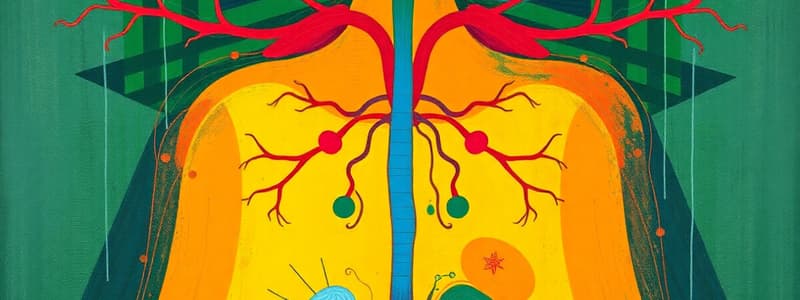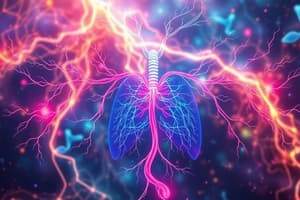Podcast
Questions and Answers
Which hormone is primarily involved in calcium homeostasis released by the thyroid gland?
Which hormone is primarily involved in calcium homeostasis released by the thyroid gland?
- Aldosterone
- Calcitonin (correct)
- Insulin
- Epinephrine
What is the shape of the right adrenal gland compared to the left adrenal gland?
What is the shape of the right adrenal gland compared to the left adrenal gland?
- Flat for both
- Cuboidal for both
- Spherical for the left, pyramidal for the right
- Pyramidal for the right, semi-lunar for the left (correct)
What regulates the secretion of hormones from the adrenal cortex?
What regulates the secretion of hormones from the adrenal cortex?
- Parathyroid hormone levels
- Inferior thyroid arteries
- Sympathetic nervous system
- Anterior pituitary gland (correct)
Where are thyroid hormones T3 and T4 synthesized?
Where are thyroid hormones T3 and T4 synthesized?
Which of the following accurately describes the blood supply of the pancreas?
Which of the following accurately describes the blood supply of the pancreas?
What is the primary function of the endocrine system?
What is the primary function of the endocrine system?
Which of the following statements correctly describes the role of hormones?
Which of the following statements correctly describes the role of hormones?
What structure is considered the central regulatory component of the endocrine system?
What structure is considered the central regulatory component of the endocrine system?
How does the anterior pituitary receive hormonal signals?
How does the anterior pituitary receive hormonal signals?
Which hormone is directly associated with water retention in the kidneys?
Which hormone is directly associated with water retention in the kidneys?
What is the primary blood supply to the posterior pituitary?
What is the primary blood supply to the posterior pituitary?
What anatomical feature lies directly superior to the anterior pituitary?
What anatomical feature lies directly superior to the anterior pituitary?
Where is the thyroid gland located in the human body?
Where is the thyroid gland located in the human body?
Which of the following hormones is primarily responsible for raising blood glucose levels?
Which of the following hormones is primarily responsible for raising blood glucose levels?
What is the primary consequence of excessive secretion of glucocorticoids?
What is the primary consequence of excessive secretion of glucocorticoids?
Which hormone is secreted in response to stress and functions to increase heart rate and blood flow to muscles?
Which hormone is secreted in response to stress and functions to increase heart rate and blood flow to muscles?
Which pancreatic hormone is responsible for inhibiting both glucagon and insulin release?
Which pancreatic hormone is responsible for inhibiting both glucagon and insulin release?
Conns disease is characterized by excessive production of which hormone?
Conns disease is characterized by excessive production of which hormone?
What is the primary effect of glucocorticoids like cortisol in response to stress?
What is the primary effect of glucocorticoids like cortisol in response to stress?
What role do catecholamines such as adrenaline play in the body?
What role do catecholamines such as adrenaline play in the body?
Which factor primarily regulates the secretion of aldosterone?
Which factor primarily regulates the secretion of aldosterone?
Which endocrine disorder is indicated by high TSH levels and low T3 and T4 levels?
Which endocrine disorder is indicated by high TSH levels and low T3 and T4 levels?
In terms of hormonal function, what is a primary action of thyroid hormones?
In terms of hormonal function, what is a primary action of thyroid hormones?
What does the renin-angiotensin-aldosterone pathway primarily regulate?
What does the renin-angiotensin-aldosterone pathway primarily regulate?
Which hormone is primarily responsible for increasing lipolysis in the body?
Which hormone is primarily responsible for increasing lipolysis in the body?
What distinguishes a disorder of the adrenal medulla from one of the adrenal cortex?
What distinguishes a disorder of the adrenal medulla from one of the adrenal cortex?
What is the primary function of glucocorticoids released from the adrenal cortex?
What is the primary function of glucocorticoids released from the adrenal cortex?
Which mechanism best describes how lipid-soluble hormones exert their effects on target cells?
Which mechanism best describes how lipid-soluble hormones exert their effects on target cells?
In the renin-angiotensin-aldosterone pathway, which hormone is the primary regulator of blood pressure and fluid balance?
In the renin-angiotensin-aldosterone pathway, which hormone is the primary regulator of blood pressure and fluid balance?
What is the role of catecholamines such as adrenaline in the body?
What is the role of catecholamines such as adrenaline in the body?
What primarily controls the release of pancreatic hormones such as insulin and glucagon?
What primarily controls the release of pancreatic hormones such as insulin and glucagon?
Which endocrine disorder is characterized by excessive secretion of growth hormone after growth plates have closed?
Which endocrine disorder is characterized by excessive secretion of growth hormone after growth plates have closed?
How does the hypothalamus influence the anterior pituitary?
How does the hypothalamus influence the anterior pituitary?
What signifies an autocrine action of hormones?
What signifies an autocrine action of hormones?
Flashcards
Endocrine System
Endocrine System
A system of glands that release hormones to maintain homeostasis and regulate bodily functions.
Hormones
Hormones
Chemical messengers that travel through the bloodstream to target cells and trigger specific responses.
Homeostasis
Homeostasis
The maintenance of a stable internal environment in the body.
Hypothalamic-Pituitary Axis
Hypothalamic-Pituitary Axis
Signup and view all the flashcards
Hypothalamus
Hypothalamus
Signup and view all the flashcards
Anterior Pituitary
Anterior Pituitary
Signup and view all the flashcards
Posterior Pituitary
Posterior Pituitary
Signup and view all the flashcards
Thyroid Gland
Thyroid Gland
Signup and view all the flashcards
Parathyroid Glands
Parathyroid Glands
Signup and view all the flashcards
Adrenal Glands
Adrenal Glands
Signup and view all the flashcards
Pancreas
Pancreas
Signup and view all the flashcards
Pancreatic Islets
Pancreatic Islets
Signup and view all the flashcards
Blood Glucose
Blood Glucose
Signup and view all the flashcards
Glucagon
Glucagon
Signup and view all the flashcards
Insulin
Insulin
Signup and view all the flashcards
Short-term Endocrine Functions
Short-term Endocrine Functions
Signup and view all the flashcards
Long-term Endocrine Functions
Long-term Endocrine Functions
Signup and view all the flashcards
Study Notes
Endocrine System Overview
- Main function is to maintain homeostasis, ensuring stable internal conditions for optimal functioning.
- Hormones, acting as chemical messengers, facilitate cell communication and homeostasis.
Short and Long-Term Functions
- Short-term functions include regulation of blood pressure, pH balance, and respiration.
- Long-term functions comprise growth, reproduction, and metabolism regulation.
Hormones
- Hormones are released in response to stimuli and help restore equilibrium, directly or indirectly.
Hypothalamic-Pituitary Axis
- Central regulatory component of the endocrine system.
- Hypothalamus integrates neural and hormonal stimuli and signals the pituitary gland.
Hypothalamus
- Located at the base of the forebrain (diencephalon).
- Receives inputs regarding temperature, blood molecules, and hormones.
- Connects to the pituitary gland via the pituitary stalk; involved in hormone secretion.
Anterior Pituitary
- Located in the sella turcica, beneath the optic chiasma.
- Releases hormones in response to hypothalamic stimuli; these hormones target other endocrine organs.
- Blood supply includes the superior hypophyseal artery and hypophyseal portal vessels.
Posterior Pituitary
- Positioned behind the anterior pituitary and connected to the hypothalamus.
- Responsible for releasing ADH (antidiuretic hormone) and oxytocin.
- Blood supply comes from the inferior hypophyseal artery.
Thyroid Gland
- Situated anterior to the trachea in the lower neck; butterfly-shaped, with two lobes connected by the isthmus.
- Releases calcitonin for calcium homeostasis and T3 and T4 hormones for metabolic regulation.
- Regulated by the anterior pituitary (TSH); supplied by superior and inferior thyroid arteries.
Parathyroid Glands
- Located on the posterior surface of each thyroid lobe; usually four but can range from two to six.
- Function in calcium and phosphate homeostasis, regulated by calcium levels.
- Blood supply comes from the inferior thyroid arteries.
Adrenal Glands
- Paired retroperitoneal glands positioned atop each kidney.
- Right gland is pyramidal; left gland is semi-lunar. Composed of medulla and cortex.
- Secrete steroid and catecholamine hormones directly into the bloodstream.
- Regulated by ACTH from the pituitary gland and sympathetic nervous system.
Pancreas
- Retroperitoneal gland located posterior and inferior to the stomach.
- Contains islets of Langerhans, which have four types of cells for endocrine and exocrine functions.
- Blood supply for the body and tail comes from branches of the splenic artery; head supplied by the celiac trunk.
Pancreatic Islets
- Pancreatic islets contain four hormone-secreting cell types:
- Alpha (α) cells (17%): secrete glucagon, which raises blood glucose (BG) levels.
- Beta (β) cells (70%): secrete insulin, which lowers BG levels.
- Delta (δ) cells (7%): secrete somatostatin, which inhibits both glucagon and insulin release.
- F or PP cells: secrete pancreatic polypeptide, inhibiting somatostatin and digestive enzyme secretion.
Endocrine Disorders and Their Associated Glands
- Addison's disease: adrenal insufficiency.
- Hypothyroidism: thyroid gland; low levels of T3 and T4 hormones.
- Cushing's disease: elevated cortisol levels; often due to excessive steroid medication.
- Diabetes: related to pancreas dysfunction.
- Conn's disease: adrenal gland; excess aldosterone production.
- Graves' disease: autoimmune thyroid condition; elevated T3 and T4 levels.
- Acromegaly: excess growth hormone from the pituitary gland.
Actions of Thyroid Hormones
- Increase basal metabolic rate and body temperature (calorigenic effect).
- Enhance glucose and fatty acid utilization.
- Stimulate lipolysis and regulate nervous tissue and bone growth and development.
Thyroid Disorders
- High TSH: low T3, low T4.
- Low TSH: high T3, high T4.
Parathyroid Glands
- Located on the posterior surface of each lobe of the thyroid (typically four, but can vary).
- Structure includes chief cells, oxyphil cells, and adipocytes.
- Function: maintain calcium and phosphate homeostasis; regulated by negative feedback based on calcium levels.
- Supplied by inferior thyroid arteries.
Adrenal Glands
- Position: paired glands situated over the kidneys, retroperitoneally; right is pyramidal and left is semi-lunar.
- Divided into cortex (secretes glucocorticoids, mineralocorticoids, and androgens) and medulla (secretes catecholamines like adrenaline and noradrenaline).
- Regulated by the pituitary gland (ACTH) for the cortex and sympathetic nervous system for the medulla.
Blood Supply to the Adrenal Glands
- Supplied by superior, middle, and inferior adrenal arteries.
- Drained by right and left adrenal veins.
Mechanisms of Hormone Action
- Lipid-soluble hormones: bind to internal receptors within target cells.
- Water-soluble hormones: bind to plasma membrane receptors, using second messenger systems for signal amplification.
Hypothalamic-Pituitary Axis
- Central regulatory component of the endocrine system.
- Hypothalamus integrates neural and hormonal stimuli, triggering pituitary signals.
Hypothalamus
- Located at the base of the forebrain (diencephalon).
- Connected to the pituitary via the pituitary stalk; receives input on temperature, blood metabolism, and hormonal levels.
- Blood supply: superior hypophyseal artery and hypophyseal portal vessels leading to the anterior pituitary.
Pituitary Gland
- Anterior Pituitary: releases hormones in response to hypothalamic stimuli; located in sella turcica, near optic chiasma (tumors can affect vision).
- Posterior Pituitary: connected to hypothalamus via the pituitary stalk; releases ADH and oxytocin; supplied by inferior hypophyseal artery.
Studying That Suits You
Use AI to generate personalized quizzes and flashcards to suit your learning preferences.




